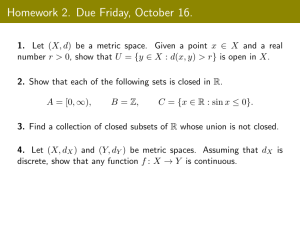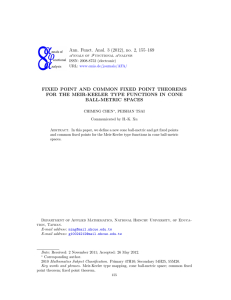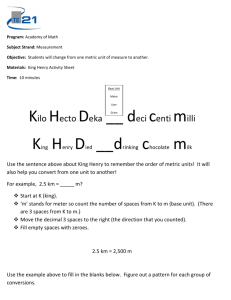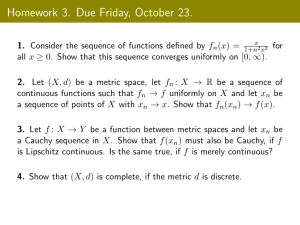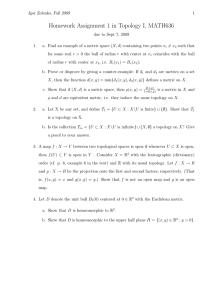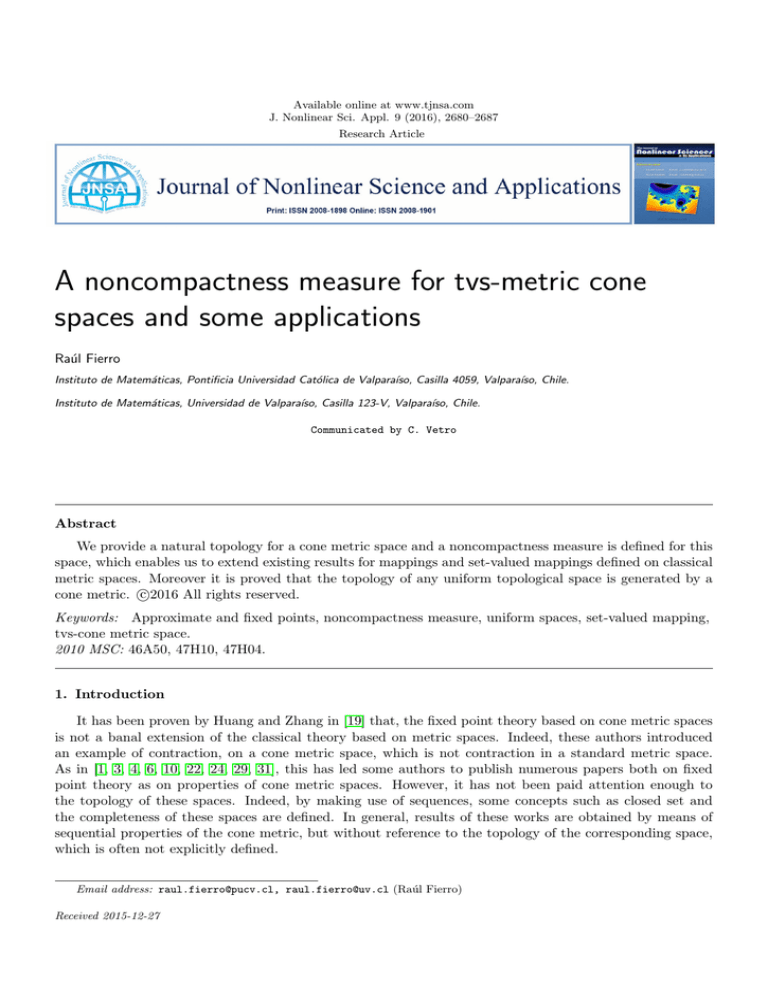
Available online at www.tjnsa.com
J. Nonlinear Sci. Appl. 9 (2016), 2680–2687
Research Article
A noncompactness measure for tvs-metric cone
spaces and some applications
Raúl Fierro
Instituto de Matemáticas, Pontificia Universidad Católica de Valparaı́so, Casilla 4059, Valparaı́so, Chile.
Instituto de Matemáticas, Universidad de Valparaı́so, Casilla 123-V, Valparaı́so, Chile.
Communicated by C. Vetro
Abstract
We provide a natural topology for a cone metric space and a noncompactness measure is defined for this
space, which enables us to extend existing results for mappings and set-valued mappings defined on classical
metric spaces. Moreover it is proved that the topology of any uniform topological space is generated by a
c
cone metric. 2016
All rights reserved.
Keywords: Approximate and fixed points, noncompactness measure, uniform spaces, set-valued mapping,
tvs-cone metric space.
2010 MSC: 46A50, 47H10, 47H04.
1. Introduction
It has been proven by Huang and Zhang in [19] that, the fixed point theory based on cone metric spaces
is not a banal extension of the classical theory based on metric spaces. Indeed, these authors introduced
an example of contraction, on a cone metric space, which is not contraction in a standard metric space.
As in [1, 3, 4, 6, 10, 22, 24, 29, 31], this has led some authors to publish numerous papers both on fixed
point theory as on properties of cone metric spaces. However, it has not been paid attention enough to
the topology of these spaces. Indeed, by making use of sequences, some concepts such as closed set and
the completeness of these spaces are defined. In general, results of these works are obtained by means of
sequential properties of the cone metric, but without reference to the topology of the corresponding space,
which is often not explicitly defined.
Email address: raul.fierro@pucv.cl, raul.fierro@uv.cl (Raúl Fierro)
Received 2015-12-27
R. Fierro, J. Nonlinear Sci. Appl. 9 (2016), 2680–2687
2681
The main aim of this paper is providing a natural topology for a cone metric space. We prove that this
topology is generated by a uniformity. Reciprocally, it is proved that the topology of any uniform space
is generated by a cone metric. Of course, the topology of a cone metric space depends strongly on the
topological vector spaces where the cone metric takes its values. For instance, when this latter topology
is locally convex, the topology of the cone metric space so is. One of the advantages of having a topology
for the spaces under our study, is that the precompact sets can be characterized by means of their cone
metrics. Indeed, in this paper a noncompactness measure is defined for these spaces and precompactness of
sets is characterized by this measure, which also enables us to define condensing mappings and condensing
set-valued mappings. Originally, this type of measure was introduced by Kuratowski in [20] allowing to
characterize relatively compact sets in complete (classical) metric spaces. Other authors such as [18, 25]
have characterized relatively compact sets in locally convex spaces. In [13], a noncompactness measure is
defined for cone metric spaces with normal cone in a Banach space. However, these authors do not prove
that the noncompactness measure of a compact set equals zero.
The Banach contraction theorem allows to prove that a non-expansive self-mapping defined on a bounded,
closed and convex subset of a Banach space has an approximate fixed point. Furthermore, if this subset
is compact, then the non-expansive self-mapping has a fixed point. A proof of these results is given, for
instance, in Chapter 3 of [17]. By making use of a general result, introduced in this work, and a version of
the Nadler theorem in the context of cone metric spaces, we prove that non-expansive set-valued mappings
with respect to cone metric, have also approximate fixed points. Moreover, when a set-valued mapping has
compact domain, it has a fixed point.
Another application, of the main results of this paper, is an extension of a fixed point theorem by Darbo
in [11], which is proved in the context of cone metric spaces.
The paper is organized as follows. The topology of a cone metric space is introduced in Section 2. Also
in this section, it is proved that cone metric spaces are uniform topological spaces and the noncompactness
measure on these spaces is presented. In Section 3 the main results are stated and proved. Finally, Section
4 is devoted to some applications to approximate and fixed points.
2. Preliminaries
Let E be a complete topological real vector space with θ as zero element and usual notations for addition
and scalar product. A cone is a nonempty closed subset P of E such that P ∩ (−P ) = {θ} and for each
α ≥ 0, αP + P ⊆ P . Given a cone P of E, a partial order is defined on E as x y, if and only if, y − x ∈ P .
We denote by x ≺ y whenever x y and x 6= y. Moreover, the notations x y means that y − x belongs
to int(P ), the interior of P . As natural, the notations x y, x y and x y mean y x, y ≺ x and
y x, respectively. In what follows, it is assumed that P is a cone of E. We refer to [2] for notations and
facts, about ordered vector spaces.
Remark 2.1. For each a, b, c ∈ E such that a b c, we have a c.
A cone metric space is a pair (X, d), where X is a nonempty set and d : X × X → E is a function
satisfying the following two conditions: i) for all x, y ∈ X, d(x, y) = θ, if and only if, x = y, and ii) for all
x, y, z ∈ X, d(x, y) d(x, z) + d(y, z).
In what follows, (X, d) and P stand for a cone metric space and the cone defining the order on E,
respectively.
Remark 2.2. Note that for all x, y ∈ X, d(x, y) θ, and d(x, y) = d(y, x) (see also [9]).
Next, we define a topology on X based on its cone metric d. Let C be a base of neighborhoods of θ and
for each C ∈ C, we denote
UC = {(x, y) ∈ X × X : d(x, y) ∈ C},
BX = {UC : C ∈ C} and UX = {U ⊂ X × X : ∃V ∈ BX , V ⊂ U }. Without loss of generality, in the sequel,
we assume every C ∈ C is balanced, i.e. for each α ∈ R such that |α| ≤ 1, we have αC ⊆ C. Notice that UX
R. Fierro, J. Nonlinear Sci. Appl. 9 (2016), 2680–2687
2682
is a uniformity on X, if and only if, BX is a fundamental system of entourages. Theorem 2.3 below shows
that indeed (X, UX ) is a uniform space.
As usual, the diagonal of X is defined as ∆ = {(x, y) ∈ X × X : x = y}.
Theorem 2.3. The family BX is a fundamental system of entourages for the uniformity UX on X. I.e.,
BX is a filter base satisfying the following three conditions:
T
(i) ∆ = C∈C UC ;
(ii) for each U ∈ BX , there exists V ∈ BX , such that V ⊂ U −1 ;
(iii) for each U ∈ BX , there exists W ∈ BX , such that W ◦ W ⊂ U .
Proof. Conditions (i) and (ii) follow directly from the definition of cone metric. Let us prove condition (iii).
Let U ∈ BX and C ∈ C satisfy U = UC . Hence, there exists B ∈ C such that B + B ⊂ C. Let W = UB and
(x, y) ∈ W ◦ W . There exists z ∈ X such that (x, z) ∈ W and (z, y) ∈ W and consequently d(x, z) ∈ B and
d(z, y) ∈ B. Thus d(x, y) d(x, z) + d(z, y) ∈ B + B ⊂ C and accordingly W ◦ W ⊂ U .
From (i), ∅ ∈
/ BX . Let A, B ∈ C and C ∈ C such that C ⊂ A ∩ B. Hence UC ⊂ UA ∩ UB . Consequently,
BX is a filter base on X × X, which concludes the proof.
In what follows, we consider the space X endowed with the topology generated by UX . Hence, a base
for the topology of X is given by means of the family {UC [a]; a ∈ X, C ∈ C}, where UC [a] = {x ∈ X :
d(x, a) ∈ C}. Moreover, it is worth noting that X satisfies the first countability axiom, whenever E does it.
In particular, when E is metrizable, X is 1◦ countable.
Remark 2.4. Notice that for each θ and a ∈ X, the ball B(a, ) = {x ∈ X : d(x, a) } is an open
set. However, in general, it is easy to give examples showing that the family of all balls is not a base for the
topology of X. Consequently, the topology generated by {B(a, ) : θ}, is, in general, weaker than the
topology of X generated by UX . In [9], this weaker topology has been considered to prove some results.
S
For each A ⊆ X and C ∈ C, we denote UC [A] = x∈A UC [x]. A subset B of X is said to be bounded,
if there exists an (order) upper bounded C ∈ C such that B × B ⊆ UC . We denote by 2X the family of all
nonempty subsets of X, by B(X) the family of all bounded subsets of X, by C(X) the family of all closed
and nonempty subsets of X and CB(X) = C(X) ∩ B(X). A subfamily H = {HC }C∈C of CB(X) × CB(X) is
defined as follows:
HC = {(A, B) ∈ CB(X) × CB(X) : A ⊆ UC [B] and B ⊆ UC [A]}.
It is well known, see [8] for instance, that H is a fundamental system of entourages for a uniformity on
CB(X). The topology on CB(X) induced by H is referred to as the H-topology. Let K(X) denote the family
of all nonempty compact subsets of X. Since K(X) ⊆ CB(X), we consider K(X) endowed with the induced
H-topology. In [27] is proved that K(X) is H-complete, if and only if, (X, UX ) so is.
In accordance with the uniformity generating the topology of X, a subset D of X is precompact, if for
each C ∈ C, there exist x1 , . . . , xr ∈ X such that D ⊆ UC [x1 ] ∪ · · · ∪ UC [xr ]. Moreover, a filter F on X
is a Cauchy filter (c.f. [7]), if for each C ∈ C, there exist A ∈ F such that A × A ⊆ UC . We define a
noncompactness measure as follows: for D ∈ B(X), MX (D) denotes the family of all C ∈ C such that there
exist x1 , . . . , xr ∈ X satisfying D ⊆ UC [x1 ] ∪ · · · ∪ UC [xr ]. Accordingly, (c.f. [7]), D ∈ B(X) is precompact,
if and only if, MX (D) = C. Thus, MX (·) is a noncompactness measure.
It is easy to see the following three properties hold:
a) MX (B) ⊆ MX (A) whenever A ⊆ B,
b) MX (A ∪ B) = MX (A) ∩ MX (B),
c) MX (A) = MX (A),
(A ∈ B(X)).
(B ∈ B(X)).
(A, B ∈ B(X)).
R. Fierro, J. Nonlinear Sci. Appl. 9 (2016), 2680–2687
d) MX (A) ⊆ C + MX (UC [A])1 ,
2683
(A ∈ B(X), C ∈ C).
Let D ⊆ X and B be a filterbase in X. We say that B converges to D, in the H-topology, if and only if,
for each C ∈ C, there exists B ∈ B such that B ⊆ UC [D] and D ⊆ UC [B].
3. Main results
We have seen that a cone space enjoys of a Hausdorff uniform structure. The next result states that any
Hausdorff uniform space has the topology induced by a cone metric.
T
Theorem 3.1. Let (X, U) be a Hausdorff uniform space, i.e. U ∈U U = ∆. Then, there exists a cone metric
d : X × X → E generating the topology of X.
Proof. It is well-known that the uniformity U is generated by a family of separating pseudo metrics {dλ }λ∈Λ
on X. Let E = RΛ be the real vector space of all functions from Λ to R, endowed with the usual operations
of addition and scalar multiplication. By considering E with the product topology and defining P =
{x ∈ E : ∀λ ∈ Λ, xλ ≥ 0}, we have P is a cone of E and a cone metric d : X × X → E is defined as
d(x, y) = {dλ (x, y)}λ∈Λ . A local base for E is given by the family C of the all sets having the form
Cλ1 ,...,λr (a, ) = {x ∈ E : max |xλi − aλi | < },
1≤i≤r
λ1 , . . . λr ∈ Λ,
> 0,
a ∈ E.
It is easy to see that {UC ; C ∈ C}, where UC = {(x, y) ∈ X × X : d(x, y) ∈ C}, is a fundamental system of
entourages generating the uniformity U. Therefore, d is a cone metric generating the topology of X.
Theorem 3.2 below extends a classical result (Theorem 1’) by Kuratowski in [20].
T
Theorem 3.2. Let B ⊆ CB(X) be a filter base on X and D = B∈B B. Suppose (X, UX ) is complete and
S
B∈B MX (B) = C. Then, the following two conditions hold:
(i) D is compact and nonempty,
(ii) B converges to D in the H-topology.
Proof. Since D is closed, X is complete and MX (D) = C, we have D is compact. Let F be the filter
generated by B, i.e., F = {A ⊆ X : ∃B ∈ B, B ⊆ A}. In order to prove D is nonempty, let F ∗ be a
ultrafilter such that F ⊆ F ∗ . Let C ∈ C and C 0 ∈ C such that C 0 + C 0 ⊆ C. By assumption, there exist
B ∈ B and x1 , . . . , xr ∈ X such that B ⊆ UC 0 [x1 ] ∪ · · · ∪ UC 0 [xr ]. Since B ∈ F ∗ and F ∗ is a ultrafilter, there
exists i ∈ {1, . . . , r} such that UC 0 [xi ] ∈ F ∗ (see Corollary in Section §6.4, Chapter I in [7], for instance).
0
Thus, UC 0 [xi ]×U
UC and consequently,
F ∗ is a Cauchy filter, which converges to some point x∗ ∈ X.
T C [xi ] ⊆ T
T
∗
But, {x } = F ∈F ∗ F ⊆ F ∈F F = B∈B B and therefore D is nonempty.
Next, we prove the convergence of B to E in the H-topology. Suppose there exists C ∈ C such that
for any B S
∈ B, B ∩ UC [D]cS6= ∅. Consequently, Be = {B ∩ LC : B ∩ UC [D]c } is a filter base on UC [D]c .
Moreover
M (B) ⊇ B∈B MX (B) = C and UC [D]c is complete. These facts imply from (i) that
B∈BeT X
T
∅ 6= B∈Be B = B∈B B ∩ UC [D]c = D ∩ UC [D]c , which is a contradiction. Therefore, there exists B ∈ B
such that B ⊆ UC [D] and the proof is complete.
Example 3.3. Let f : X → X be a continuous mapping and for each C ∈ C denote BS
C = {x ∈ X : f (x) ∈
UC [x]}. Suppose (X, UX ) is complete and B = {BC ; C ∈ C} is a filter base satisfying C∈C MX (BC ) = C.
Then, from Theorem 3.2, the set of the all fixed points of f is compact and nonempty. Moreover, B converges
to this set in the H-topology.
1
C + MX (UC [A]) = {C + C 0 : C 0 ∈ MX (UC [A])}
R. Fierro, J. Nonlinear Sci. Appl. 9 (2016), 2680–2687
2684
Corollary 3.4 (Kuratowski [20]). Let (X, d) be a complete metric space, αX be the noncompactnessTmeasure
on X, {Bn }n∈N be a decreasing sequence of nonempty, closed and bounded subsets of X and D = n∈N Bn .
Suppose limn→∞ αX (Bn ) = 0. Then, the following two conditions hold:
(i) D is compact and nonempty,
(ii) B converges to D in the Hausdorff metric.
Proof. Let C = {(−, ) : > 0} and C ∈ C. Hence, there existsS > 0 such that C = (−, ). Let n0 ∈ N
such that αX (Bn0 ) < . Hence, C ∈ MX (Bn0 ) and consequently n∈N MX (Bn ) = C. Therefore, conditions
(i) and (ii) follows from Theorem 3.2, which completes the proof.
T
Remark 3.5. Note that whether B is countable, in Theorem 3.2, in order to B∈B B is compact and
nonempty, it suffices that X is sequentially complete, with respect to the uniformity UX .
Let T : D ⊆ X → 2X be a set-valued mapping. We say that T is condensing, if for each A ⊆ D such
that A ∈ B(X) and MX (A) 6= C, we have T (A) ∈ B(X), MX (A) ⊆ MX (T (A)) and MX (A) T
6= MX (T (A)).
X
0
A subfamily D of 2 is said to be stable under intersections, if for any D ⊆ D, we have D∈D0 D ∈ D.
Theorem 3.6. Suppose (X, UX ) is complete. Let D be stable under intersections subfamily of CB(X),
D ∈ D and T : D → 2D be a condensing set-valued mapping. Then, there exists C ∈ D, a compact subset of
D, such that T (C) ⊆ C.
Proof.TLet x0 ∈ D and Σ = {K ∈ D : x0 ∈ K ⊆ D and T
T (K) ⊆ K}. Due to D ∈ Σ, we have Σ 6= ∅. Let
B = K∈Σ K and C = {x0 } ∪ T (B). We have T (B) ⊆ K∈Σ T (K) ⊆ B and x0 ∈ B. Moreover, since B
is closed, C ⊆ B. Thus T (C) ⊆ T (B) ⊆ C, C ∈ Σ and B = C. Since D is stable under intersections, we
have C ∈ D. From properties b) and c), we obtain MX (C) = MX (T (B)) = MX (T (C)) and due to T is
condensing, we have MX (C) = C. Since C is closed, we have C is compact and the proof is complete.
Example 3.7. Suppose X is a complete topological vector space. Hence, under conditions and notations
stated in Theorem 3.6, D can be chosen as the family of all nonempty convex sets and consequently, there
exists a compact convex subset C of X such that T (C) ⊆ C. This fact, in case the Schauder conjecture were
correct (see The Scottish Book [21], Problem 54), would imply the existence of a fixed point of T , when T
is a single-valued mapping.
4. Applications to approximate and fixed points
In this section, the cone P is assumed to be normal (c.f. [2]), i.e. for each C ∈ C, and x, y ∈ C, one has
{z ∈ E : x z y} ⊆ C. Let T : D ⊆ X → 2X be a set-valued mapping. A point x∗ ∈ D is said to be
a fixed point of T , if x∗ ∈ T x∗ and T is said to have an approximate fixed point (see [4, 12, 14, 26, 30] for
related concepts), if for any C ∈ C, there exists x ∈ X such that T x ∩ UC [x] 6= ∅. The set of all fixed points
of T is denoted by Fix(T ).
A concept extending the classical Hausdorff metric is stated as follows. For x ∈ X and A, B ∈ CB(X),
we define s(x, B) and s(A, B) as follows:
[
s(x, B) =
{ θ : d(x, b) }
b∈B
and
s(A, B) =
\
s(a, B) ∩
a∈A
\
s(b, A).
b∈B
Let k ≥ 0 and T : X → CB(X) be a set-valued mapping satisfying
kd(x, y) ∈ s(T x, T y),
for all x, y ∈ X.
(4.1)
R. Fierro, J. Nonlinear Sci. Appl. 9 (2016), 2680–2687
2685
As in [5, 6, 10, 22, 28], we say T is a contraction whenever k < 1. In this work, the set-valued mapping
T is said to be non-expansive, whenever (4.1) is satisfied with k = 1. In [16, 24, 31], other definitions of
contraction for set-valued mappings are given in the context of cone metric spaces. Also, these definitions
are based on extensions of the classical Hausdorff metric.
The following lemma is stated and proved in [28] (see also [6]) whether E is a locally convex space and
in [31] whether E is a Banach space. Since we are not assuming these conditions and the completeness
condition stated here is different, we give an explicit proof, which is simple and similar to that given by
Nadler in [23], for set-valued contraction with respect to the classical Hausdorff metric.
Lemma 4.1. Suppose (X, UX ) is complete and let T : X → CB(X) be a contraction. Then, T has a fixed
point.
T
Proof. Let x0 ∈ X and x1 ∈ T x0 . Since kd(x0 , x1 ) ∈ x∈T x0 s(x, T x1 ) ⊆ s(x1 , T x1 ), there exists x2 ∈ T x1
such that d(x1 , x2 ) kd(x0 , x1 ). It follows by induction that there exists a sequence {xn }n∈N in X such
that, for each n ∈ N, xn+1 ∈ T xn and d(xn+1 , xn+2 ) kd(xn , xn+1 ). Hence, for each n, p ∈ N, d(xn , xn+p ) {k n /(1 − k)}d(x0 , x1 ) and since E is normal, {xn }n∈N is a Cauchy sequence with respect to UX . Thus,
there exists x∗ ∈ X such that {xn }n∈N converges to x∗ . On the other hand, kd(xn+1 , x∗ ) ∈ s(T xn , T x∗ ) and
hence there exists yn ∈ T x∗ such that d(xn+1 , yn ) kd(xn+1 , x∗ ). Accordingly, d(x∗ , yn ) d(x∗ , xn+1 ) +
kd(xn+1 , x∗ ). Let C, C 0 ∈ C and N ∈ N such that C 0 + C 0 ⊆ C and d(xn , x∗ ) ∈ C 0 for all n ≥ N . We have,
d(x∗ , xn+1 ) + kd(xn+1 , x∗ ) ∈ C 0 + kC 0 ⊆ C and since E is normal, d(x∗ , yn ) ∈ C, for all n ≥ N . This proves
that {yn }n∈N converges to x∗ and due to T x∗ is closed, we have x∗ ∈ T x∗ , which completes the proof.
Next, we assume X is a vector space endowed with a cone norm on E. That is, there exists a function
k · k : X → E satisfying the following three conditions: (a) for all x ∈ X, kxk = 0 implies x = 0, (b) for
all x ∈ X and λ ∈ R, kλxk = |λ|kxk, and (c) for all x, y ∈ X, kx + yk kxk + kyk. We denote by d the
cone metric induced by k · k and, in what follows, for A, B ∈ CB(X), s(A, B) is defined in terms of this cone
metric.
Since E is normal, it is easy to see that the topology of X, generated by UX , makes continuous its vector
space operations. Consequently, with respect to this topology, X turns out a topological vector space.
Theorem 4.2. Suppose (X, UX ) is complete, D is a nonempty closed convex and bounded subset of X and
T : D → 2D is a non-expansive set-valued mapping. Then, T has an approximate fixed point.
Proof. For a fixed z0 ∈ D and > 0, we define T : D → 2D by T x = z0 + (1 − )T x. Notice that T is welldefined and, for any x, y ∈ X, s(T x, T y) = (1 − )s(T x, T y). Consequently, (1 − )d(x, y) ∈ s(T x, T y),
i.e. T is a contraction. It follows from Lemma 4.1 that there exists x ∈ D such that x ∈ T x . Let
y ∈ T x such that x = z0 + (1 − )y . We have kx − y k = kz0 − y k c, where c is an upper bound
of {d(u, v) : u, v ∈ D}. Since E is normal, for each C ∈ C we can choose > 0 such that kx − y k ∈ C.
Therefore, T x ∩ UC [x ] 6= ∅ and the proof is complete.
Given T : D ⊆ X → 2D and C ∈ C, we denote BC [T ] = {x ∈ D : T x ∩ UC [x] 6= ∅}.
Theorem 4.3. Suppose (X, UX ) is complete, D is a nonempty
closed convex and bounded subset of X,
S
T : D → K(D) is a non-expansive set-valued mapping and C∈C MX (BC [T ]) = C. Then, Fix(T ) is compact
and nonempty.
Proof. From Theorem
S 4.2, BC [T ] is nonempty and hence, BT = {BC [T ]; C ∈ C} is a filter base of closed sets.
On the other hand, C∈C MX (BC [T ]) = C holds due to the assumption and c) in Section 2. Consequently,
T
T
Theorem 3.2 implies that C∈C BC [T ] 6= ∅. Since Fix(T ) = C∈C BC [T ] , it suffices to prove that
\
C∈C
BC [T ] =
\
C∈C
BC [T ].
(4.2)
R. Fierro, J. Nonlinear Sci. Appl. 9 (2016), 2680–2687
2686
In order to obtain (4.2), we prove that for each C ∈ C, there exists C 0 ∈ C such that BC 0 (T ) ⊆ BC [T ]. Let
C ∈ CT
and choose C 0 ∈ C satisfying C 0 + C 0 ⊆ C. Let y ∈ BC 0 (T ) and suppose that T y ∩ UC [y] = ∅. Since
T y = C∈C UC [T y] and T y is compact, there exists C 00 ∈ C such that UC 00 [T y] ∩ UC [y] = ∅. Notice that
for each x ∈ UC 0 [y], UC 0 [x] ⊆ UC [y]. Let x ∈ UC 00 [y]. Hence d(x, y) ∈ s(T x, T y) and thus, for each z ∈ T x
there exists b ∈ T y such that d(z, b) d(x, y). Since d(x, y) ∈ C 00 and E is normal, we have d(z, b) ∈ C 00 .
Consequently, for each x ∈ UC 00 [y], we have T x ⊆ UC 00 [T y] and by defining Vy = UC 0 [y] ∩ UC 00 [y] we obtain
that, for each x ∈ Vy , T x ∩ UC 0 [x] ⊆ UC 00 [T y] ∩ UC [y] = ∅, i.e. Vy ⊆ BC 0 (T )c , which is a contradiction.
Therefore, BC 0 (T ) ⊆ BC (T ) and the proof is complete.
Corollary 4.4. Suppose D is a nonempty compact and convex subset of X and T : D → K(D) is a
non-expansive set-valued mapping. Then, Fix(T ) is (compact and) nonempty.
Remark 4.5. Suppose C is a base of neighborhoods of θ consisting of convex sets. Hence, {UC [0]; C ∈ C} is
a base of convex neighborhoods of 0 ∈ X. Consequently, X is a locally convex space whether E so is.
For each D ⊆ X, let Q(D) be the family of all nonempty compact convex subsets of D.
Lemma 4.6. Suppose E is a locally convex space, C ∈ Q(X) and let T : C → Q(C) be a continuous
set-valued mapping. Then, T has a fixed point.
Proof. It directly follows from Theorem 2 by Fan in [15].
The following result extends, to locally convex spaces and for continuous multi-functions, a known
theorem by Darbo in [11].
Theorem 4.7. Suppose E is a locally convex space and (X, UX ) is complete. Let D be a nonempty bounded
closed and convex subset of X and T : D → C(D) be a condensing multi-function with convex images. Then,
T has a fixed point.
Proof. Let D be the subfamily of CB(X) consisting of all convex subsets of X. Since D is stable under
intersections, Theorem 3.6 implies that there exists a compact and convex subset C of X such that T (C) ⊆ C.
Since C ∈ Q(X) and for each x ∈ C, T x ∈ Q(C), it follows from Lemma 4.6 that T has a fixed point, which
completes the proof.
Acknowledgements
This work was partially supported by FONDECYT grant 1120879 from the Chilean government.
References
[1] R. P. Agarwal, M. A. Khamsi, Extension of Caristi’s fixed point theorem to vector valued metric spaces, Nonlinear
Anal., 74 (2011), 141–145. 1
[2] C. D. Aliprantis, R. Tourky, Cones and Duality, American Mathematical Society, Providence, Rhode Island,
(2007). 2, 4
[3] I. Altun, V. Rakoc̆ević, Ordered cone metric spaces and fixed point results, Comput. Math. Appl., 60 (2010),
1145–1151. 1
[4] A. Amini, J. Fakhar, J. Zafarani, Fixed point theorems for the class S-KKM mappings in abstract convex spaces,
Nonlinear Anal., 66 (2007), 14–21. 1, 4
[5] A. Azam, N. Mehmood, Multivalued fixed point theorems in cone tvs-cone metric spaces, Fixed Point Theory
Appl., 2013 (2013), 13 pages. 4
[6] A. Azam, N. Mehmood, J. Ahmad, S. Radenović, Multivalued fixed point theorems in cone b-metric spaces, J.
Inequal. Appl., 2013 (2013), 9 pages. 1, 4
[7] N. Bourbaki, Elements of Mathematics, General Topology. Part 1, Hermann, Paris, (1966). 2, 3
[8] C. Castaing, M. Valadier, Convex Analysis and Measurable Multifunctions, Springer-Verlag, Berlin, (1977). 2
[9] C. Çevik, I. Altun, Vector metric spaces and some properties, Topol. Methods Nonlinear Anal., 34 (2009), 375–
382. 2.2, 2.4
R. Fierro, J. Nonlinear Sci. Appl. 9 (2016), 2680–2687
2687
[10] S. H. Cho, J. S. Bae, Fixed point theorems for multivalued maps in cone metric spaces, Fixed Point Theory Appl.,
2011 (2011), 7 pages. 1, 4
[11] G. Darbo, Punti uniti in transformazioni a codominio non compatto, Rend. Semin. Mat. Univ. Padova, 24 (1955),
84–92. 1, 4
[12] S. Dhompongsa, W. Inthakon, A. Kaewkhao, Edelstein’s method and fixed point theorems for some generalized
nonexpansive mappings, J. Math. Anal. Appl., 350 (2009), 12–17. 4
[13] J. Eisenfeld, V. Lakshmikantham, Fixed points theorems through abstract cones, J. Math. Anal. Appl., 52 (1975),
25–35. 1
[14] R. Espı́nola, W. A. Kirk, Fixed points and approximate fixed points in product spaces, Taiwanese J. Math., 5
(2001), 405–416. 4
[15] K. Fan, A generalization of Tychonoff ’s fixed point theorem, Math. Ann., 142 (1961), 305–310. 4
[16] R. Fierro, Fixed point theorems for set-valued mappings on TVS-cone metric spaces, Fixed Point Theory Appl.,
2015 (2015), 7 pages. 4
[17] K. Goebel, W. A. Kirk, Topics in Metric Fixed Point Theory, Cambridge University Press, Cambridge, United
Kingdom, (1990). 1
[18] C. J. Himmelberg, J. R. Porter, F. S. Van Vleck, Fixed point theorems for condensing multifunctions, Proc. Amer.
Math. Soc., 23 (1969), 635–641. 1
[19] L. G. Huang, X. Zhang, Cone metric spaces and fixed point theorems of contractive mappings, J. Math. Anal.
Appl., 332 (2007), 1468–1476. 1
[20] C. Kuratowski, Sur les espaces completes, Fund. Math., 15 (1939), 301–309. 1, 3, 3.4
[21] R. D. Mauldin, The Scottish Book: mathematics from the Scottish Café, Birkhäuser, Basel, (1981). 3.7
[22] N. Mehmood, A. Azam, L. D. R. Koc̆inac, Multivalued fixed point results in cone metric spaces, Topology Appl.,
179 (2015), 156–170. 1, 4
[23] S. B. Nadler, Multivalued contraction mappings, Pacific J. Math., 30 (1969), 475–488. 4
[24] S. Radenović, S. Simić, N. Cakić, Z. Golubović, A note on tvs-cone metric fixed point theory, Math. Comput.
Model., 54 (2011), 2418–2422. 1, 4
[25] S. Reich, Fixed points in locally convex spaces, Math. Z., 125 (1972), 17–31. 1
[26] S. Reich, A. J. Zaslavski, Approximate fixed points of nonexpansive mappings in unbounded sets, J. Fixed Point
Theory Appl., 13 (2013), 627–632. 4
[27] J. Saint-Raymond, Topologie sur l’ensemble des compacts non vides d’un espace topologique séparé, Séminaire
Choquet, 9 (1969/70), 6 pages. 2
[28] W. Shatanawi, V. Ćojbašić, S. Radenović, A. Al-Rawashdeh, Mizoguchi-takahashi-type theorems in tvs-cone
metric spaces, Fixed Point Theory Appl., 2012 (2012), 7 pages. 4
[29] G. Soleimani Rad, H. Rahimi, S. Radenović, Algebraic cone b-metric spaces and its equivalence, Miskolc Math.
Notes, (In Press). 1
[30] T. Suzuki, Fixed point theorems and convergence theorems for some generalized nonexpansive mappings, J. Math.
Anal. Appl., 340 (2008), 1088–1095. 4
[31] D. Wardowski, On set-valued contractions of Nadler type in cone metric spaces, Appl. Math. Lett., 24 (2011),
275–278. 1, 4

